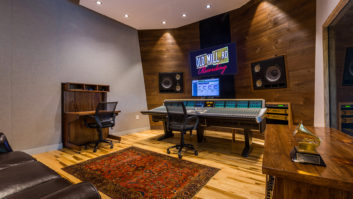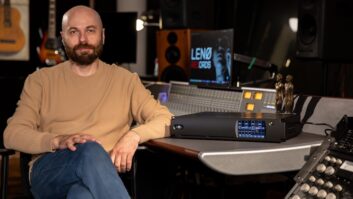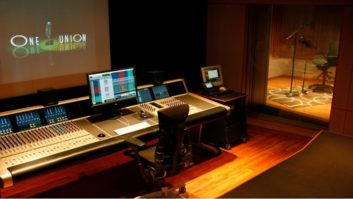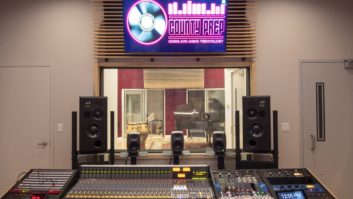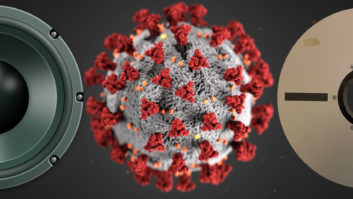New York, NY (September 25, 2019)—There’s no business like streaming business, as the record industry has discovered. More than 60 percent of U.S. recorded music revenues now come from paid streaming subscriptions, according to the RIAA, partially offsetting the steep downturn in physical sales since the late ’90s. But while it took some time for the labels to find their footing in the 21st century, on the front lines, at recording studios in and around Philadelphia, Dallas and Washington, D.C., business is, well, the same as it ever was.
Don Zientara started Inner Ear Studio 30 years ago in his basement in Arlington, VA, just across the Potomac River from the nation’s capital, later relocating to a bigger place. He helped put D.C. hardcore on the map, recording bands such as Minor Threat and Fugazi, and while we may not see the likes of such a music movement again, he’s still busy, working with talent from the region and on the occasional corporate project.
Zientara is old school, working on a vintage Amek Angela analog desk and, frequently, an Otari MTR-90 tape machine, as well as Pro Tools. “Most of the rock bands that I record want to go to tape first for the drums and the bass; they find that it’s far more powerful. Then we dump it into the computer and it keeps that power,” he says.
If there is any threat to his livelihood, says Zientara, it’s from people with limited recording experience spending money on gear for the home instead of booking time in a commercial studio. “Retailers are out to sell equipment, and we’re left high and dry,” he says. “It’s a story that’s been told many, many times, but it keeps repeating.”
Happily, enough customers understand that a dedicated space and a recording engineer’s expertise have value. “Picking out the equipment, matching this microphone to that particular voice? That takes an engineer. Over time, they realize that getting good audio has value,” Zientara believes.
A 1980s UK record industry campaign claimed home taping was killing music. Could home recording pose a similar threat? “Yes, you can put up some marginal stuff on Bandcamp or wherever,” says Zientara, “and it’s a democratic internet and all that, but is that really where we’re going? Do we want a lot of stuff out there that’s just marginal?”
Pleasantry Lane Studio in Dallas, TX, was started 20 years ago by Salim Nourallah, a recording artist, engineer and producer who has enjoyed some success working with Old 97’s, Rhett Miller and The Damnwells. That success, along with being voted best producer by the Dallas Observer for eight consecutive years, allows him to pick and choose his clients.
“I only record people that I like or whose music I’m interested in,” he says, a decision based on his own early, unsatisfactory recording experiences, where the studio staff were just not engaged. “Maybe [it was] because they have to record every single person who comes in the door, whether they like their music or not,” he says. “So I don’t advertise. People just find me.”
About three years ago, Nourallah partnered with Sarah Henry at Palo Santo Records to reissue underappreciated catalog projects on vinyl. The label also releases music by new, mainly local artists. “Texas has so much great music and I don’t feel like it’s being properly represented to the rest of the country or the world,” he says.
Nourallah had Dallas-based, UK-born studio designer Bob Suffolk build out the current version of his studio. “That was 12 years ago, when I had major-label money,” he says. Suffolk is now finishing up a vocal/amp booth and a drum room that would make Glyn Johns proud. “I’m a big fan of ’70s drums in a fairly dead room,” says Nourallah, an avowed Anglophile.
When his band signed its first indie deal in the ’90s, says Nourallah, only major-label artists had their own facilities. Since then, the price of pro audio gear has fallen, democratizing the music recording business. “It’s incredible that guys like me can now have a facility like this. I feel like Tom Petty. How do I have a studio like this when I didn’t sell a bazillion records?”
Alex Santilli opened his John Storyk-designed Spice House Sound in Philadelphia’s Fishtown neighborhood five years ago. The studio has never advertised and was open almost before he realized it. “We had people come and ask us if they could come in, so the ball just started rolling. I didn’t even feel like we were ready to open yet.”
Business has been great, he says: “Every year has been the best year so far. We really can’t complain—but we’ll see what happens in two years when we open!”
Spice House attracts business from around the city and the region, such as Japanese Breakfast, Michelle Zauner’s latest project, which is generating a lot of buzz. “She was in Little Big League, a band I used to do mastering work for. It shows that you just need to keep at it until you find something that clicks.”
A partnership with Y-Not Radio means that Santilli also gets to record and shoot video of live performances by touring bands from Australia and the UK, such as The Wombats, he says. Indeed, video and photo shoots for advertising have provided an unforeseen revenue stream. “It’s strange how many people have used the studio as a filming location. I wasn’t expecting that. I don’t know how these people find out about us, but we’re happy about it.” Clients have included VH1, Discovery Channel, NFL and Coors Light.
Santilli is something of a gear whisperer, constantly improving Spice House’s vintage equipment, such as the facility’s Auditronics mixing desk, but clients don’t appreciate everything he does. “I spent months rebuilding a tape machine and made it the most perfectly measuring machine, and then no one ever used it,” he says.
He reports that between the console and the speakers, the level of distortion in the studio is almost impossible to measure. “We try to keep everything big and clean and clear sounding, so when you run it through an 1176 or a Distressor, you can [mess] it all up exactly the way you want.”
The speakers he references are his own design, 10 years in the making. “We built the room around a set of speakers, and then I rebuilt the set of speakers around the room,” he says. “The challenge is having super low distortion but also super high volume handling for clients who listen back at jet engine levels. I didn’t realize people wanted to do that.”
The current iteration generates about 700W of continuous power, he says. “If you can handle 140 dB, they’ll do it—but please don’t.”


